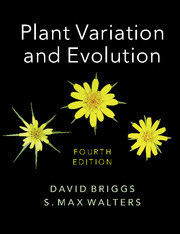Book contents
- Frontmatter
- Contents
- Preface to the Fourth Edition
- Acknowledgements
- Note on names of plants
- List of abbreviations
- 1 Investigating plant variation and evolution
- 2 From Ray to Darwin
- 3 Early work on biometry
- 4 Early work on the basis of individual variation
- 5 Post-Darwinian ideas about evolution
- 6 DNA: towards an understanding of heredity and molecular evolution
- 7 Breeding systems
- 8 Intraspecific variation and the ecotype concept
- 9 Pattern and process in plant populations
- 10 Pattern and process: factors interacting with natural selection
- 11 Populations: origins and extinctions
- 12 Species and speciation: concepts and models
- 13 Allopatric speciation and hybridisation
- 14 Abrupt speciation
- 15 The species concept
- 16 Flowering plant evolution: advances, challenges and prospects
- 17 Historical biogeography
- 18 The evolutionary impact of human activities
- 19 The taxonomic challenge ahead
- 20 Conservation: from protection to restoration and beyond
- Glossary
- References
- Index
20 - Conservation: from protection to restoration and beyond
Published online by Cambridge University Press: 05 June 2016
- Frontmatter
- Contents
- Preface to the Fourth Edition
- Acknowledgements
- Note on names of plants
- List of abbreviations
- 1 Investigating plant variation and evolution
- 2 From Ray to Darwin
- 3 Early work on biometry
- 4 Early work on the basis of individual variation
- 5 Post-Darwinian ideas about evolution
- 6 DNA: towards an understanding of heredity and molecular evolution
- 7 Breeding systems
- 8 Intraspecific variation and the ecotype concept
- 9 Pattern and process in plant populations
- 10 Pattern and process: factors interacting with natural selection
- 11 Populations: origins and extinctions
- 12 Species and speciation: concepts and models
- 13 Allopatric speciation and hybridisation
- 14 Abrupt speciation
- 15 The species concept
- 16 Flowering plant evolution: advances, challenges and prospects
- 17 Historical biogeography
- 18 The evolutionary impact of human activities
- 19 The taxonomic challenge ahead
- 20 Conservation: from protection to restoration and beyond
- Glossary
- References
- Index
Summary
It is clear that many thousands of species are at present vulnerable or endangered by human activities (Frankel & Soulé, 1981; Primack, 1993, 2010; Given, 1994; Meffe & Carroll, 1994; Frankel, Brown & Burdon, 1995). Broadly, two conservation options are available. Plants may either be conserved ex situ, in such places as Botanic Gardens, or in situ in their native habitats. Here we consider, briefly, the early history of conservation, and how theory and practice have changed – from protection, management, to reintroduction/restoration and creative conservation.
Ex situ conservation
Endangered species, including those at the very edge of extinction, are often conserved ex situ in Botanic Gardens and arboreta (Briggs, 2009; Hardwick et al., 2011), of which there now more than 2700 worldwide (Ali & Trivedi, 2011). The scale of the holdings of Botanic Gardens is impressive: perhaps 25–30% of all vascular plants are represented in the collections (Wyse Jackson & Sutherland, 2000). Some gardens hold very large general collections (e.g. Kew with c.10% of the world's plants), while others have specialist collections (e.g. The Arnold Arboretum, Boston, USA, grows several hundred species of temperate tree). Botanic Gardens Conservation International (BGCI), Richmond, England, organises and coordinates the conservation efforts of gardens (www.bgci.org/). Regrettably, most Botanic Gardens are located in temperate areas of the world, and it is costly to grow tropical plants in the glasshouses of Europe and North America. However, there are some notable Botanic Gardens in the tropics (Heywood & Wyse Jackson, 1991), and, if the number could be increased, it would be possible to conserve many tropical species of plants cheaply out of doors, and provide important centres for economic development and exploitation of plant biodiversity.
Other specialist gardens also play a key role in ex situ conservation. In England, the National Trust has now relocated its conservation activities from Knightshayes Court, Devon. It was necessary to move to another site because of an outbreak of Sudden Oak Death (caused by the fungus Phytophthora ramorum). The new ex situ facilities are designed to secure the future of the rare and endangered plant species that grow in the Trust's ‘200 gardens, 100 landscape parks’ and ‘in the many wild places it manages’ (Morris, 2012).
- Type
- Chapter
- Information
- Plant Variation and Evolution , pp. 449 - 477Publisher: Cambridge University PressPrint publication year: 2016



